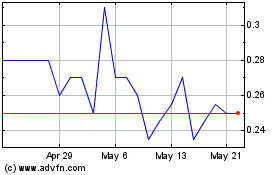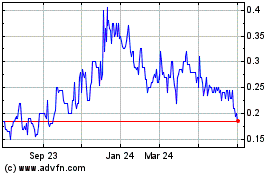Triumph Gold Corp. (TSX-V: TIG | OTCMKTS: TIGCF |
Frankfurt: 8N61) (“Triumph Gold” or “the Company”) is pleased to
announce results from 896.72 metres of diamond drilling in 3 holes
from the
Blue Sky Zone (“BSZ”) within the
Revenue Deposit at the
Freegold Mountain
Project (Figure 1), highlighted by 106.50 metres (“m”) of
0.76 grams per ton (“g/t”) gold equivalent1 (“AuEq”) in RVD21-05.
Highlights:
During the 2021 exploration program, three drill
holes were completed at the Blue Sky Zone totaling
896.72 metres (Figure 2, Tables 1 and 2).
- Drilling encountered multiple
styles of mineralization including porphyry-style stockwork veins,
disseminated sulphides, sulphide breccias, and epithermal
veins
-
Drilling added near-surface mineralization of the Blue Sky
Zone within the open pit resource (Figure 2)
-
106.50 metres of 0.76 g/t AuEq from 120.00 metres in
RVD21-05
- Containing 0.27 g/t gold (“Au”),
5.43 g/t silver (“Ag”), 0.22% copper (“Cu”), and 0.014% molybdenum
(“Mo”)
- 26.82 metres of 0.67 g/t AuEq from
169.18 metres in RVD21-06
- Containing 0.50 g/t Au, 1.54 g/t
Ag, 0.07% Cu, and 0.004% Mo
- 15.65 metres of 0.49 g/t AuEq from
205.35 metres in RVD21-06
- Containing 0.22 g/t Au, 2.01 g/t
Ag, 0.09% Cu, and 0.017% Mo
- 71.00 metres of 0.51 g/t AuEq from
204 metres in RVD21-07
- Containing 0.19 g/t Au, 1.39
g/t Ag, 0.06% Cu, and 0.036% Mo
- RVD21-06
intersected porphyry-style mineralization with 27.00 metres of 0.44
g/t AuEq from 244.00 metres
- Containing 0.17 g/t Au, 2.38 g/t
Ag, 0.09% Cu, and 0.015% Mo
The Blue Sky Zone is defined by
12 drill holes: three holes from the 2021 program (Table 1) and
nine historical holes (Table 3). The Blue Sky Zone
is a NE-striking, near vertical body of Au-Cu-Ag-Mo mineralization
that remains open at depth. The Revenue Deposit is
made up of the Blue Sky Zone, WAu
Zone, and zones of Cu-Mo-Au porphyry-style
mineralization.
The Blue Sky Zone has been
expanded 100 metres westwards and towards the surface with a
modeled strike length of 210 metres. The zone has an average width
of 70 metres and a depth of 480 metres below surface. The 2021
drilling program expanded both the Blue Sky Zone
and the WAu Zone and reduced the gap between the
two zones to 65 metres (Figure 2).
46% of the 6,615 metres of the 2021 diamond
drilling program have been reported to date (PR#21-11). Further
updates will be provided when the results for the remainder of the
2021 exploration program are received and interpreted from the
Nucleus Deposit, Big Creek South Fault Zone, the Orbit Zone, and
regional exploration activities (Figure 1).
Table 1. 2021 Drilling Highlights
https://www.globenewswire.com/NewsRoom/AttachmentNg/fb03f71e-f6c9-45d6-862f-17018c00796a
1 Refer to the Reference and Disclosure section
below for compositing techniques and AuEq calculations.
Table 2. 2021 Drill Hole Summary (Coordinates in
UTM NAD83 Zone 8N)
https://www.globenewswire.com/NewsRoom/AttachmentNg/70207817-5c6b-4c78-ac2a-c249ea80145e
Table 3. Reinterpretation of Historical Blue Sky Zone
Intercepts
https://www.globenewswire.com/NewsRoom/AttachmentNg/f61794f7-6914-4833-8684-07f46f9e32e4
1,2 Refer to the Reference and Disclosure
section below for compositing techniques and AuEq calculations.
“We are pleased to report these exceptional
drill results that support the teams’ geological interpretation of
the Blue Sky Zone extending towards surface within
the open-pit resource. We are excited that the WAu
Zone and Blue Sky Zone continue to grow
bulk-tonnage mineralization within the Revenue
Deposit,” stated Brian May, President, Triumph Gold
Corp.
Detailed Interpretation and Geology
RVD21-05 intercepted the Blue Sky
Zone and returned 106.50 metres of 0.76 g/t AuEq from
120.00 metres. This intercept is located 60 metres southwest of
RVD18-16, which had an intercept of 110.42 metres grading 1.86 g/t
AuEq (PR#18-08). The 2021 program expanded the Blue Sky
Zone 100 metres westwards and towards the surface (Figure
2). The updated expression of the Blue Sky Zone is
now modeled to be 65 metres from the WAu Zone,
suggesting the two zones may be linked in a NE orientation (Table 1
and Figure 2).
Mineralization at the Blue Sky Zone is hosted
within hydrothermally-altered granodiorite and contains two
overlapping mineralization events:
-
The first and most abundant mineralization event is associated with
strong potassic alteration with K-feldspar grading outwards into
biotite, suggesting a high-temperature porphyry zone. Sulphide
mineralization (chalcopyrite, molybdenite, pyrite and pyrrhotite)
is characterized by clots, veinlets, and disseminations.
-
The second phase of mineralization is hosted by epithermal
quartz-calcite veins with mineralization of chalcopyrite,
molybdenite, galena, sphalerite +/- bismuthinite and visible gold,
representing metal enrichment.
Porphyry-style mineralization was intercepted
south of the modeled Blue Sky Zone (Figure 2, Tables 1 and 4).
Porphyry-style mineralization consists of local sulphide +/- quartz
stockwork veining with broad zones of disseminated sulphide
mineralization surrounding vein clusters and local fine grained
native gold (Figure 4).
https://www.globenewswire.com/NewsRoom/AttachmentNg/ac3a0c44-be24-49a3-b064-17de2d7cef57
Figure 1. 2021 Drilling Areas on the Freegold Mountain
Project.
https://www.globenewswire.com/NewsRoom/AttachmentNg/a81d7682-f658-45a6-94b4-050407d40aff
Figure 2. Plan View and Long Section of the
Blue Sky Zone and the WAu Zone
within the $1500/ounce (“oz”) Au pit shell of the 2020 mineral
resource estimate at the Revenue Deposit
(PR#20-02). Significant intercepts in the three drill holes of this
release are listed in Table 1 and are depicted by purple
(Blue Sky Zone) and cyan bars (porphyry-style vein
+/- disseminated mineralization). Historical Blue Sky
Zone intercepts are depicted by blue bars and are listed
in Table 3. Wireframes were generated using Micromine’s implicit
modeling tool.
https://www.globenewswire.com/NewsRoom/AttachmentNg/4f50ce90-d1fc-4c85-ac90-048b6493ebff
Figure 3. Blue Sky Zone, coarse chalcopyrite
(Cpy) and pyrite (Py) mineralization from RVD21-05 at 160.30
metres. This 1.5-metre sample interval from 160 metres returned
0.41 g/t Au, 10.10 g/t Ag, 0.40% Cu, and 0.028% Mo.
https://www.globenewswire.com/NewsRoom/AttachmentNg/873dbb2e-166f-4a42-957a-e565cb5ad6ba
Figure 4. Pyrite (Py), bismuthinite (Bis), and
visible gold (VG) mineralization in porphyry-style veinlets hosted
within strongly silicified granodiorite from RVD21-07 at 46.25
metres. This 0.5-metre sample from 46 metres returned 1.29 g/t Au,
0.60 g/t Ag, and 0.04% Cu.
Table 4. 2021 Significant Intercepts
(Highlighted Intercepts are reported in Table 1)
https://www.globenewswire.com/NewsRoom/AttachmentNg/98a32d8a-07b3-4272-8098-bc3add65efe4
References and Disclosures
1 Gold equivalent [AuEq] is used for
illustrative purposes, to express the combined value of gold,
silver, copper, and molybdenum as a percentage of gold. No
allowances have been made for recovery losses that would occur in a
mining scenario. AuEq is calculated using US$1,750.00 per troy
ounce of gold, US$24.00 per troy ounce of silver, US$4.00 per pound
of copper and US$15.00 per pound of molybdenum:
AuEq = Au g/t + (Ag g/t X $24.00 / $1750.00) +
(Cu% X $4.00 X 22.0462) / ($1750.00 / 31.10) + (Mo% X $15.00 X
22.0462) / ($1750.00 / 31.10)
Reported assay intervals are calculated using
Micromine’s grade compositing tool using >0.25 g/t AuEq cutoff,
constrained by no more than 6 metres of consecutive internal
dilution. High-grade intervals are reported using >1.0 g/t AuEq
cutoff with no more than 5 metres of consecutive internal
dilution.
Reported assays are uncut weighted averages and
represent drilled core lengths. The true width of reported
mineralization is unknown.
2 Reinterpretation of the Blue
Sky Zone was completed by reviewing
historical drill holes along the NE trend. Geological data (core
logs, assays, and core photos) was inspected for structural and
geochemical signatures that match characteristics of the
Blue Sky Zone. AuEq values are
reported using current metal prices for both historical and newly
identified intercepts.
Sample Preparation and QAQC
Diamond drill holes at the Freegold Mountain
Project are drilled using HTW and NTW core sizes (70.92 millimetres
and 56.00 millimetres diameter respectively). Drill core samples
average 1.63 metres in length with a minimum length of 0.50 metres
and a maximum length of 2.00 metres except at the top of RVD21-07
where core loss resulted in a sample length of 4.66 metres. Drill
core is cut along the long axis of the core over the entire length
of the drill hole. Sample intervals are defined by mineralization,
lithology, structure, and alteration boundaries.
Sample preparation is completed at ALS
Whitehorse with sample pulps shipped to ALS Vancouver for analyses.
Samples are dried and crushed to 70% less than 2 millimetres with a
250-gram riffle-split and pulverized to better than 85% passing 75
microns (PREP-31).
A 50-gram sample from the pulp is analyzed for
gold using fire assay techniques and atomic absorption spectroscopy
with detection limits of 0.005-10 parts per million (“ppm”)
(Au-AA24). Gold overlimit values are re-analyzed using a
gravimetric finish with an upper detection limit of 10,000 ppm
(Au-GRA22). A 0.25 gram sample from the pulp is analyzed with
multi-element geochemistry (ME-ICP61) using a 4-acid near total
digestion and induced coupled plasma atomic emission spectroscopy
(ICP-AES) providing 33 elements (Ag, Al, As, Ba, Be, Bi, Ca, Cd,
Co, Cr, Cu, Fe, Ga, K, La, Mg, Mn, Mo, Na, Ni, P, Pb, S, Sb, Sc,
Sr, Th, Ti, Tl, U, V, W, Zn).
Sample Quality Assurance/Quality Control
(“QAQC”) measures include unmarked certified reference materials
(CRMs), rock blanks, and field duplicates are inserted into the
sample sequence and make up 5% of the samples submitted to the lab
for holes reported in this release. Additional QAQC checks are
ongoing in accordance with 43-101 standards.
National Instrument 43-101
Disclosure
The technical content of this news release has
been reviewed and approved by Triumph Gold’s President, Brian May,
P.Geo., a “Qualified Person” as defined in National Instrument
43-101 – Standards of Disclosure for Mineral Projects of the
Canadian Securities Administrators. He has also verified the data
disclosed, including sampling, analytical and test data, and the
underlying technical information in this news release.
About Triumph Gold Corp.
Triumph Gold Corp. is a Canadian based,
growth-oriented exploration and development company with a district
scale land package in mining friendly Yukon. The Company’s 100%
owned, road accessible, flagship Freegold Mountain Project in the
Dawson Range Au-Cu Belt is host to three NI 43-101 Mineral Deposits
(Nucleus, Revenue, and Tinta Hill). The Project is 200 square
kilometres and covers an extensive section of the Big Creek Fault
Zone, a structure directly related to epithermal gold and silver
mineralization as well as gold-rich porphyry copper
mineralization.
Led by an experienced management and technical
team, Triumph Gold is focused on actively advancing the Freegold
Mountain Project using multidiscipline exploration and evaluation
techniques.
The Company owns 100% of the Big Creek and
Tad/Toro copper-gold properties situated along strike of the
Freegold Mountain Project within the Dawson Range.
The Company also owns 100% of the Andalusite
Peak copper-gold property, situated 36 km southeast of Dease Lake
within the Stikine Range in British Columbia.
For more information, please
visit triumphgoldcorp.com.
On behalf of the Board of
Directors
Signed “John Anderson"
John Anderson, Executive Chairman
For further information about Triumph Gold please
contact:
John Anderson, Executive
ChairmanTriumph Gold Corp.(604)
218-7400janderson@triumphgoldcorp.com
Nancy MassicotteIR Pro Communications
Inc.(604)
507-3377nancy@irprocommunications.com
Neither the TSX Venture Exchange nor its
Regulation Services Provider (as that term is defined in policies
of the TSX Venture Exchange) accepts responsibility for the
adequacy or accuracy of this release.
This news release contains forward-looking
information, which involves known and unknown risks, uncertainties
and other factors that may cause actual events to differ materially
from current expectation. Important factors - including the
availability of funds, the results of financing efforts, the
completion of due diligence and the results of exploration
activities - that could cause actual results to differ materially
from the Company's expectations are disclosed in the Company's
documents filed from time to time on SEDAR (see www.sedar.com).
Readers are cautioned not to place undue reliance on these
forward-looking statements, which speak only as of the date of this
press release. The company disclaims any intention or obligation,
except to the extent required by law, to update or revise any
forward-looking statements, whether as a result of new information,
future events or otherwise.
Triumph Gold (TSXV:TIG)
Historical Stock Chart
From Dec 2024 to Jan 2025

Triumph Gold (TSXV:TIG)
Historical Stock Chart
From Jan 2024 to Jan 2025
